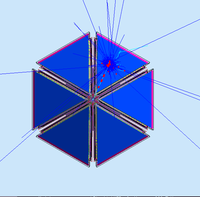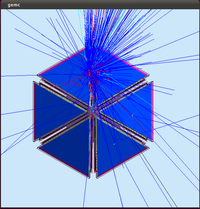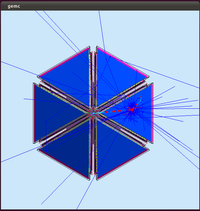Difference between revisions of "Phi angle gcard vs. LUND"
(Created page with "Using GEMC 2.5, I found an interesting behavior in defining phi in the gcard vs. the LUND file For the gcard: Here is the gcard <gcard> <detector name="../../../clas12…") |
|||
| (2 intermediate revisions by the same user not shown) | |||
| Line 27: | Line 27: | ||
~/src/CLAS/GEMC/2.0/Linux__Ubuntu16.04-x86_64-gcc5.4.0/gemc/2.5/gemc -N=3 eg12_NoLUND.gcard | ~/src/CLAS/GEMC/2.0/Linux__Ubuntu16.04-x86_64-gcc5.4.0/gemc/2.5/gemc -N=3 eg12_NoLUND.gcard | ||
| − | |||
| − | |||
For the LUND file: | For the LUND file: | ||
| Line 51: | Line 49: | ||
</gcard> | </gcard> | ||
| − | Here is the LUND file | + | Here is the LUND code (part of interest) and the file itself |
| + | |||
| + | Float_t Theta=25*3.1415026/180; | ||
| + | Float_t Phi=0.0; | ||
| + | |||
| + | Float_t P=6; | ||
| + | Int_t i; | ||
| + | for(i=0;i<NumEvents;i++) | ||
| + | { | ||
| + | |||
| + | if(RasterType==0) | ||
| + | { | ||
| + | Zvert=0; | ||
| + | Xvert=0; | ||
| + | Yvert=0; | ||
| + | |||
| + | } | ||
| + | |||
1 1 1 1 1 1.00029 0.0718059 0.937771 1.48222 0.789865 | 1 1 1 1 1 1.00029 0.0718059 0.937771 1.48222 0.789865 | ||
| Line 75: | Line 90: | ||
Here is the GEMC command line | Here is the GEMC command line | ||
| + | |||
| + | ~/src/CLAS/GEMC/2.0/Linux__Ubuntu16.04-x86_64-gcc5.4.0/gemc/2.5/gemc -INPUT_GEN_FILE="LUND,NoRaster_25theta_0phi.LUND" -N=3 eg12.gcard | ||
| + | |||
| + | The GEMC gui output for the LUND file is on the left and the gcard output is on the right | ||
| + | |||
| + | [[File:GEMC 0phi LUND.png|200px]] | ||
| + | [[File:0phi gcard.png|200px]] | ||
| + | |||
| + | Below is a 60 degree rotation using the gcard and a 30 degree rotation using the LUND file | ||
| + | [[File:Gcard 60DegRot.png|200px]] | ||
| + | [[File:LUND 30DegRot.png|200px]] | ||
Latest revision as of 19:46, 20 October 2016
Using GEMC 2.5, I found an interesting behavior in defining phi in the gcard vs. the LUND file
For the gcard:
Here is the gcard
<gcard>
<detector name="../../../clas12/fc/forwardCarriage" factory="TEXT" variation="original"/>
<detector name="../../../clas12/dc/dc" factory="TEXT" variation="ccdb"/>
<detector name="../../../clas12/ec/ec" factory="TEXT" variation="original"/>
<detector name="../../../clas12/ctof/ctof" factory="TEXT" variation="original"/>
<detector name="../../../clas12/ftof/ftof" factory="TEXT" variation="java"/>
<detector name="../../../clas12/htcc/htcc" factory="TEXT" variation="original"/>
<detector name="../../../clas12/magnets/solenoid" factory="TEXT" variation="original"/>
<detector name="../../../clas12/pcal/pcal" factory="TEXT" variation="javageom"/>
<option name="SCALE_FIELD" value="clas12-torus-big, -1"/>
<option name="HALL_FIELD" value="clas12-solenoid"/>
<option name="BEAM_P" value="e-, 6.0*GeV, 25.0*deg, 0*deg"/>
<option name="SPREAD_V" value="(1.0,0.0)cm"/>
</gcard>
Here is the GEMC command line
~/src/CLAS/GEMC/2.0/Linux__Ubuntu16.04-x86_64-gcc5.4.0/gemc/2.5/gemc -N=3 eg12_NoLUND.gcard
For the LUND file:
Here is the gcard
<gcard>
<detector name="../../../clas12/fc/forwardCarriage" factory="TEXT" variation="original"/>
<detector name="../../../clas12/dc/dc" factory="TEXT" variation="ccdb"/>
<detector name="../../../clas12/ec/ec" factory="TEXT" variation="original"/>
<detector name="../../../clas12/ctof/ctof" factory="TEXT" variation="original"/>
<detector name="../../../clas12/ftof/ftof" factory="TEXT" variation="java"/>
<detector name="../../../clas12/htcc/htcc" factory="TEXT" variation="original"/>
<detector name="../../../clas12/magnets/solenoid" factory="TEXT" variation="original"/>
<detector name="../../../clas12/pcal/pcal" factory="TEXT" variation="javageom"/>
<option name="SCALE_FIELD" value="clas12-torus-big, -1"/>
<option name="HALL_FIELD" value="clas12-solenoid"/>
</gcard>
Here is the LUND code (part of interest) and the file itself
Float_t Theta=25*3.1415026/180; Float_t Phi=0.0;
Float_t P=6;
Int_t i;
for(i=0;i<NumEvents;i++)
{
if(RasterType==0)
{
Zvert=0;
Xvert=0;
Yvert=0;
}
1 1 1 1 1 1.00029 0.0718059 0.937771 1.48222 0.789865
1 -1 1 11 0 0 0 2.53564 5.43788 6 0.000511 0 0 0
1 1 1 1 1 1.00029 0.0718059 0.937771 1.48222 0.789865
1 -1 1 11 0 0 0 2.53564 5.43788 6 0.000511 0 0 0
1 1 1 1 1 1.00029 0.0718059 0.937771 1.48222 0.789865
1 -1 1 11 0 0 0 2.53564 5.43788 6 0.000511 0 0 0
1 1 1 1 1 1.00029 0.0718059 0.937771 1.48222 0.789865
1 -1 1 11 0 0 0 2.53564 5.43788 6 0.000511 0 0 0
1 1 1 1 1 1.00029 0.0718059 0.937771 1.48222 0.789865
1 -1 1 11 0 0 0 2.53564 5.43788 6 0.000511 0 0 0
1 1 1 1 1 1.00029 0.0718059 0.937771 1.48222 0.789865
1 -1 1 11 0 0 0 2.53564 5.43788 6 0.000511 0 0 0
1 1 1 1 1 1.00029 0.0718059 0.937771 1.48222 0.789865
1 -1 1 11 0 0 0 2.53564 5.43788 6 0.000511 0 0 0
1 1 1 1 1 1.00029 0.0718059 0.937771 1.48222 0.789865
1 -1 1 11 0 0 0 2.53564 5.43788 6 0.000511 0 0 0
1 1 1 1 1 1.00029 0.0718059 0.937771 1.48222 0.789865
1 -1 1 11 0 0 0 2.53564 5.43788 6 0.000511 0 0 0
1 1 1 1 1 1.00029 0.0718059 0.937771 1.48222 0.789865
1 -1 1 11 0 0 0 2.53564 5.43788 6 0.000511 0 0 0
Here is the GEMC command line
~/src/CLAS/GEMC/2.0/Linux__Ubuntu16.04-x86_64-gcc5.4.0/gemc/2.5/gemc -INPUT_GEN_FILE="LUND,NoRaster_25theta_0phi.LUND" -N=3 eg12.gcard
The GEMC gui output for the LUND file is on the left and the gcard output is on the right
Below is a 60 degree rotation using the gcard and a 30 degree rotation using the LUND file



